The quickest Bible study method to unlock the original God-intended significance of Scripture is through mastering Biblical Hebrew words, with no fuss.
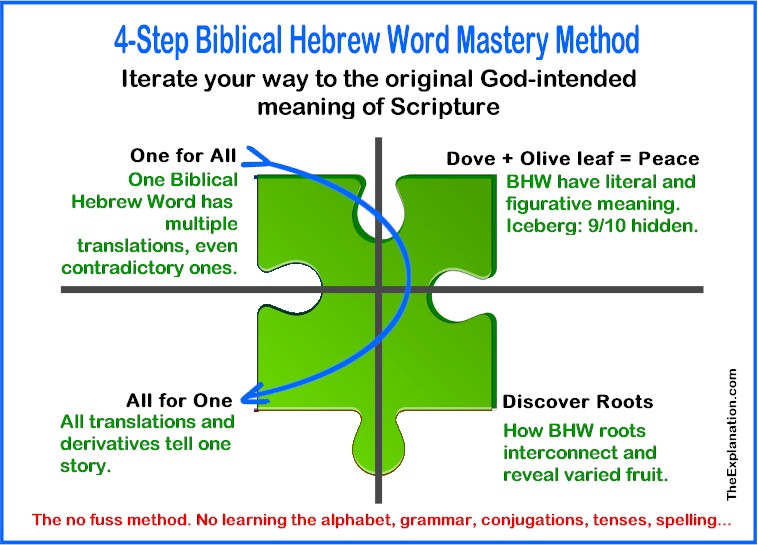
This breakthrough Bible study method is easier than you think, takes less time, and all the Bible tools are freely available online. If you want to understand what consciousness and mind are, give it a chance. Follow this Bible study through the next few chapters of Mind-Body Problem Solved and you’ll definitely reach that goal.
(Mind-Body Problem Solved, chapter 7)
Let’s jump right in. Go to UnlockBibleMeaning.com, the only Bible Study method online 24/7/365 free toolkit we’ll need to reach The Explanation. Find Genesis 2:7. We could switch (drop-down menu on the right) to either Strong’s Concordance or the Interlinear Bible. Let’s choose the latter. Here’s why.
You probably don’t know Hebrew, maybe you want to learn it, which is commendable. But it is difficult, starting with a brand new alphabet that reads from right to left. You’ll be reading letter-by-letter, like a three-year-old for months! It’ll take you years of struggle, energy, and lots of $$££€€¥¥ if you take a course. Furthermore, realize that Hebrew scholars are not in agreement as to the meaning of Hebrew Scriptures anyway, so, frankly, you’re not much further ahead using such a Bible study method in your quest to unlock Bible meaning.
I suggest you give this unique Bible study method a try. Notice (reading from right to left) …and breathed into his nostrils the breath of life. In English we have the word breath twice, breathed… the breath… Now, compare the two Hebrew words וַיִּפַּ֥ח and נִשְׁמַ֣ת. It’s not rocket science to see they are not the same, by a long shot. The Strong numbers H5301 and H5397 confirm this fact. See how easy that was, with no fuss?
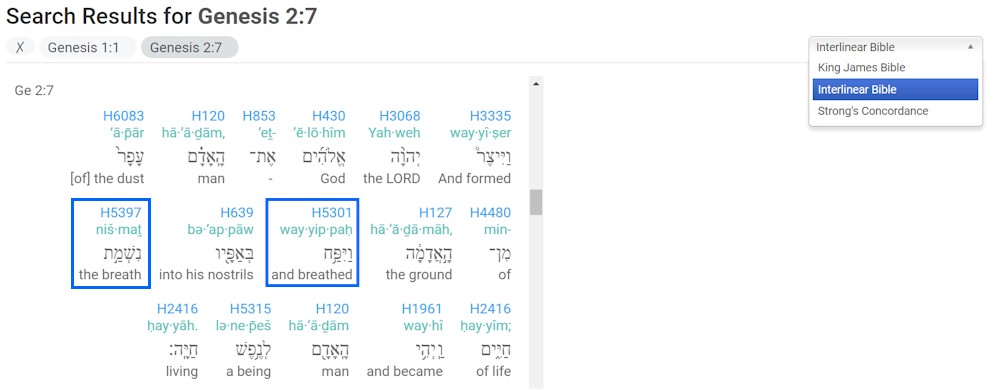
The same English word breath is, in fact, two different Hebrew words. What you’ve discovered is important for understanding the limits of translations. And therefore your comprehension of the God-intended meaning. That’s the reason you need this easy-to-apply Bible study method to unlock the original meaning of Scripture.
Let’s continue with a search for the Bible expression breath of life. There are four instances. This time we’ll use Strong’s to compare the numbers.
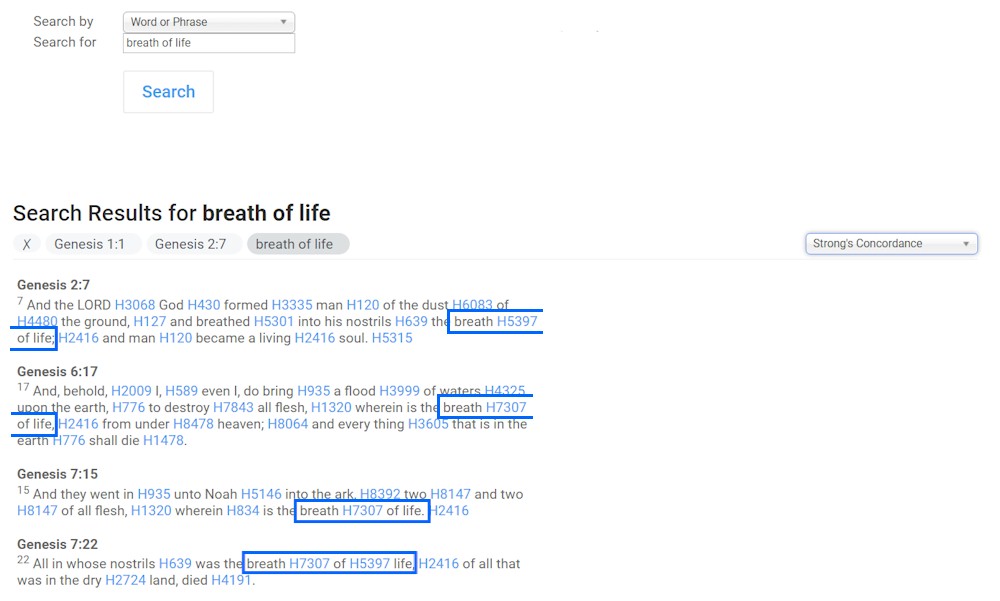
Wow. Only Gen. 2:7 has H5397. The other three have H7307, although Gen. 7:22 has both H7307 and H5397 for breath. What’s going on here? Somewhere there’s a translation anomaly. You realize you cannot detect this in English. Furthermore, from a humankind point of view, we’re discussing the most fundamental aspect of what a human is, the breath of life. Have you ever heard of this dilemma, let alone a solution? No wonder nobody knows what a human is and what consciousness and mind are. But you will find clear definitions.
We’ve identified a huge translation problem with one of the most fundamental Bible concepts, the breath of life: one English word breath, translated from three different Hebrew words (H5397, H5301, H7307). We will clear up this dilemma.
For now, let’s summarize the Bible study method we’ll use throughout this book, Mind-Body Problem Solved, to arrive at the God-intended original meaning of the breath of life and many other biblical concepts.
4-Step Biblical Hebrew Word Mastery
We’ll use breath of life in Gen. 2:7, to illustrate the efficiency and validity of the Bible study method. Click on H5397 (breath in Gen. 2:7), and the corresponding Strong’s reference displays in the right column. H is for Hebrew (G = Greek) and it is the 5397th alphabetically listed word among the 8674 unique Hebrew words used to compose the Old Testament.
- The first part of Strong’s reference always presents the Hebrew, the literation, and pronunciation. Then Stong’s annotation, which is his summary, after his study, of the meaning of this word.
- The second part starts with a bold KJV (King James Version) followed by all the English language translations the KJV Bible scholars rendered that one Hebrew word. On occasion, you’ll also see x, + signs, which are words in the Authorized and Revised Versions, including the American variations.
For our word breath, H5397, the English translations are blast, (that) breath(-eth), inspiration, soul, spirit. Five different English translations. Some Hebrew words have 50+ renderings!
This brings us to the 4-Step Bible study method.
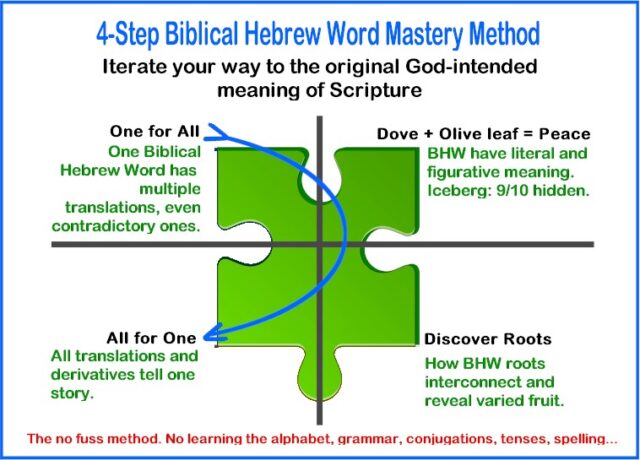
1. One for All
One Hebrew word can have multiple meanings. Our Hebrew word נְשָׁמָה – neshama – H5397 has five translations. Why not one-for-one? Many think that it’s simply a matter of finding the best translation, word-for-word, one word, and substituting that English word every time we see the Hebrew word. This is decidedly not the way the KJV academics saw the translation process. We have multiple words. How do we explain this, and what’s the implication for understanding the God-given meaning of the one Hebrew word?
Note that an aspect of this first step is amongst these multiple words, some can be contradictory or at least conflicting. We shall return to this in a moment.
2. Figurative Meanings

A flying dove is a physical bird. An olive branch is a physical twig with leaves. But put them together and you have a figurative symbol for peace. Apart, they are simple physical objects, together they have an unknown, hidden figurative meaning. Most people know this, even if they don’t know the origin of the symbol. It is from the end of Noah’s flood (whether you think it existed or not is not the point here), when a dove with an olive sprig returned to the ark, signifying dry land had appeared, the waters had receded and the world was at peace.
A child knows a dove is a bird and a piece of wood with leaves comes from a tree. But, it would not know, that together, they represent peace. Figurative meanings are like the 9/10 hidden, underwater part of an iceberg. You simply do NOT know it’s present unless someone explains it to you. Until you get The Explanation, you’re flying blind.
That 9/10 of the iceberg is the most important. Here’s why. Most Bible readers and students study their Bibles as if they were steering the Titanic, with disastrous results. They do NOT see the 9/10 hidden figurative writing in front of their eyes.
Take breath, H5793, for example. Breath is physical, everybody knows what breathing is all about, we all do it. But the translations include inspiration and spirit. Those are invisible, hidden, non-tangible, untouchable. I daresay, few know breath is neshama in Gen. 2:7 and fewer that it has the figurative meaning inspiration and spirit. 9/10 of understanding is hidden from you. In that situation, it is impossible to know what a human being is.
Mastering the figurative meanings of Biblical Hebrew words is one of the key reasons people do not understand their Bible. The 4-Step Bible study method focuses your attention on these hidden gems. Instead of sinking into Bible confusion, you will have eye-opening revelations of the original God-intended meaning of Scripture.
3. Root meanings
Words in Biblical Hebrew build mainly on a three-letter base. For instance, in English, oculus, binoculars, monocle come from the root word ocular (to see) Look at Strong’s annotation for breath. Note from H5395 (נָשַׁם). This always points to the linked root. Let’s click and display it
נָשַׁם nâsham naw-sham’; a primitive root; properly, to blow away, i.e. destroy:
KJV – destroy.
Note the primitive root with the three letters, נָשַׁם, which you’ll find in all the derivatives like נְשָׁמָה (the מָ changes form to ם at the end of a word, but it’s the same letter). This is Biblical Hebrew with no fuss. All you have to do is compare the letters.
Now for the clincher. In Genesis 2:7, God blew LIFE into the first human’s nostrils. What is the root meaning of neshama? DESTROY. Wow, you weren’t expecting that, were you? That’s step 1, multiple, even contradictory meanings. This sure is paradoxical.
A personal note here, I studied 2 years of advanced Hebrew with the Institute of Biblical Studies in Jerusalem to validate the Bible study method I’m teaching you. When I pointed out the contradictory nature of some words, my teacher and fellow students shunned the idea. I kept at it and before long they were identifying such conflicts and in agreement with the principle. I guarantee you this Bible study method gives valuable results, as you can already see.
It’s 100% sure, the Biblical Hebrew word, neshama means both blow and blow away. And we have a problem on our hands :), which we will solve.
4. All for One
The fourth step of the Bible study method is the key destination for every Biblical Hebrew word. ALL the translations/meanings (multiple, contradictory, figurative, roots) for a given Biblical Hebrew word must tell ONE STORY. That’s it. Bibles give us basically a word-for-word translation. However.
Each Biblical Hebrew word tells ONE COHERENT STORY. ALL the multiple meanings weave together to narrate the original God-intended meaning.
That, and that alone, is what we’re praying, meditating, and studying to reach. Each word is a puzzle piece with its one-and-only shape. The various meanings reveal the contours of each word. When we really tell the word story, we’ll understand WHERE and HOW it assembles with ALL the other pieces of the puzzle. Religious and theological confusion comes from an incomplete understanding of the pieces and forcing them into the wrong place in the puzzle.
This Bible study method The Explanation uses for all its Bible commentaries narrates the word stories and assembles them with adjoining words until we build out the full puzzle. Giving us the God-intended meaning of His purpose for the Universe and humankind.

In chapter 1, I asked ten questions about Genesis 2:7 and asserted theology can’t and doesn’t answer them. Neshama, giving and destroying life, is the key piece of our puzzle. We must get the narrative right or we won’t assemble the puzzle correctly. This image represents the answers to all those questions.
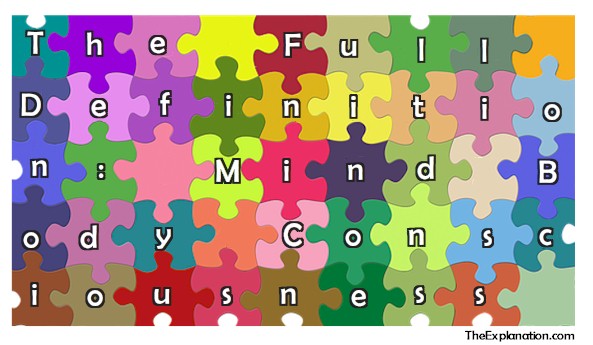
The Mind-Body Problem Solved is narrating the exciting stories of each Biblical Hebrew word and assembling them into the God-intended, original message of Scripture. We will reveal the contours of neshama and explain why it’s both a giver and snuffer of life. We’ll reach coherent completeness illustrated by the image Full Definition: Mind, Body, Consciousness.
Dig Deeper into The Explanation
Online Study Courses to Uncover the Mystery of Adam and Eve’s Nakedness… with no fuss. Free video mini-course revealing the God-intended meaning of Scripture via Biblical Hebrew. It’s so easy, it’ll blow you away. Join now and add new motivation to your Bible study.
Join The Explanation Newsletter to stay informed of updates. and future events. No obligations, total privacy, unsubscribe anytime, if you want.
The Explanation series of seven books. Free to read online or purchase these valuable commentaries on Genesis 1-3 from your favorite book outlet. E-book and paperback formats are available. Use this link to see the details of each book and buy from your favorite store.

Since you read all the way to here… you liked it. Please use the Social Network links just below to share this information from The Explanation, Fastest Bible Study Method to Grasp God-intended Meaning

Let’s Connect!